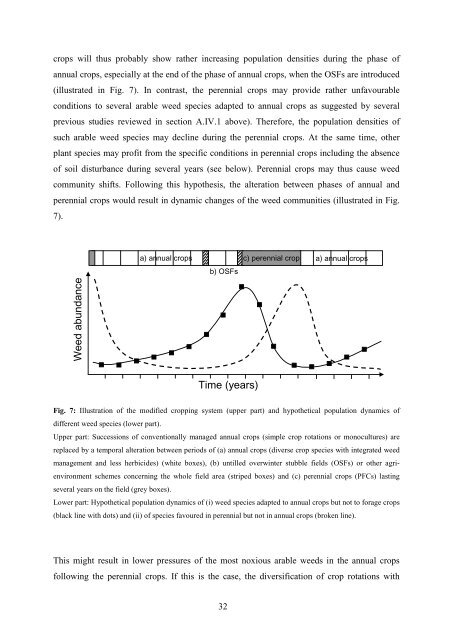Diversifying crop rotations with temporary grasslands - Université de ...
Diversifying crop rotations with temporary grasslands - Université de ...
Diversifying crop rotations with temporary grasslands - Université de ...
You also want an ePaper? Increase the reach of your titles
YUMPU automatically turns print PDFs into web optimized ePapers that Google loves.
<strong>crop</strong>s will thus probably show rather increasing population <strong>de</strong>nsities during the phase of<br />
annual <strong>crop</strong>s, especially at the end of the phase of annual <strong>crop</strong>s, when the OSFs are introduced<br />
(illustrated in Fig. 7). In contrast, the perennial <strong>crop</strong>s may provi<strong>de</strong> rather unfavourable<br />
conditions to several arable weed species adapted to annual <strong>crop</strong>s as suggested by several<br />
previous studies reviewed in section A.IV.1 above). Therefore, the population <strong>de</strong>nsities of<br />
such arable weed species may <strong>de</strong>cline during the perennial <strong>crop</strong>s. At the same time, other<br />
plant species may profit from the specific conditions in perennial <strong>crop</strong>s including the absence<br />
of soil disturbance during several years (see below). Perennial <strong>crop</strong>s may thus cause weed<br />
community shifts. Following this hypothesis, the alteration between phases of annual and<br />
perennial <strong>crop</strong>s would result in dynamic changes of the weed communities (illustrated in Fig.<br />
7).<br />
Weed abundance<br />
a) annual <strong>crop</strong>s c) perennial <strong>crop</strong><br />
a) annual <strong>crop</strong>s<br />
b) OSFs<br />
Time (years)<br />
Fig. 7: Illustration of the modified <strong>crop</strong>ping system (upper part) and hypothetical population dynamics of<br />
different weed species (lower part).<br />
Upper part: Successions of conventionally managed annual <strong>crop</strong>s (simple <strong>crop</strong> <strong>rotations</strong> or monocultures) are<br />
replaced by a temporal alteration between periods of (a) annual <strong>crop</strong>s (diverse <strong>crop</strong> species <strong>with</strong> integrated weed<br />
management and less herbici<strong>de</strong>s) (white boxes), (b) untilled overwinter stubble fields (OSFs) or other agrienvironment<br />
schemes concerning the whole field area (striped boxes) and (c) perennial <strong>crop</strong>s (PFCs) lasting<br />
several years on the field (grey boxes).<br />
Lower part: Hypothetical population dynamics of (i) weed species adapted to annual <strong>crop</strong>s but not to forage <strong>crop</strong>s<br />
(black line <strong>with</strong> dots) and (ii) of species favoured in perennial but not in annual <strong>crop</strong>s (broken line).<br />
This might result in lower pressures of the most noxious arable weeds in the annual <strong>crop</strong>s<br />
following the perennial <strong>crop</strong>s. If this is the case, the diversification of <strong>crop</strong> <strong>rotations</strong> <strong>with</strong><br />
32

















